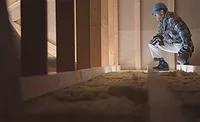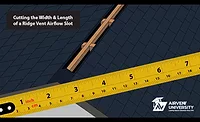Attic Airflow is a Roof’s ‘Insurance Policy’

Proper attic ventilation helps a residential roof meet its life expectancy because it helps to fight summertime heat buildup, wintertime moisture buildup and ice dams in snow regions. Additionally, the full terms of the shingle warranty are tied to proper attic ventilation and building code clearly specifies proper attic ventilation.
Yet during our best practices in residential attic ventilation seminars for roofing professionals across North America, we’re increasingly hearing: “Homeowner’s insurance refuses to pay the cost for the attic ventilation and so the homeowner is asking us to skip it; which means the brand-new roof will not have proper attic ventilation.”
That’s a potentially costly domino effect insurance companies can put an end to by including attic ventilation with every replacement roof claim.
The Roof is at Risk
Attic ventilation is a system of intake vents (placed in the eaves/soffit or low on the roof) and exhaust vents (placed at or near the roof peak). There’s a reason balanced attic ventilation is specified in the International Residential Building Code (IRC) — it helps the roof’s performance and longevity.
In our poll of residential roofing contractors across North America last spring, 77% of the homes today have improper attic ventilation, including not enough or incorrect ventilation. Quality-conscious roofing contractors will likely bring this up during the attic and roof inspection when a roof has been affected by a storm and an insurance claim is in progress. Not including the costs to either add proper attic ventilation for the new roof or upgrade the existing attic ventilation to meet current code puts the roof at risk with Mother Nature daily.
In the warmer months, heat is the concern. As the sun bakes the roof, the heat radiates into the attic. If it’s not properly vented out of the attic, it transfers into the living space. That increases the burden on the air conditioning system, any indoor cooling fans and the refrigerator. Meanwhile, up on the roof, your brand-new shingles are exposed to elevated temperatures that could reduce their service life.
In the colder months, moisture is the concern. The average family of four generates 2-4 gallons of water vapor daily through cooking, cleaning, showering, breathing, perspiration, indoor plants, hanging wet clothes indoors and storing firewood inside. During the winter, that moisture seeks a cooler, dryer place — the attic. If it’s not vented properly out of the attic it could condense as frost or water droplets and drip onto the attic insulation. In time, mold, mildew and poor indoor air quality can result.
In cold climates, attic ventilation is also part of a multi-step fight against ice dams.
The Shingle Warranty is at Risk
The full terms of the warranty for the new roof are tied directly to proper, balanced attic ventilation. It’s spelled out in the shingle warranty. Proper, balanced attic ventilation includes intake vents (in the soffit/eaves or low on the roof) and exhaust vents (at or near the peak of the roof). The official representing organization of asphalt shingle manufacturers, ARMA, highlights this in its technical bulletin for residential roofing: the roof needs balanced attic ventilation. Therefore, the brand-new roof being purchased and installed for thousands of dollars is incomplete without proper, balanced attic ventilation.
Insurers Could Save Money, Too!
Paying for proper attic ventilation during an insurance claim could save the insurance companies money in the future. That’s how Sabrina Johnson, president of KDCO Home Improvement Inc., in Akron, Ohio, sees it.
“Proper attic ventilation will decrease the expedited dry out of the shingles. Therefore, during hail and wind storms as the age of the roof increases, the roof will be much more pliable and able to sustain hail without fracturing the mating,” Johnson said. “This will help the insurance companies keep the costs of buying new roofs due to prematurely dried roofs to a minimum.”
Johnson, whose company specializes in residential roofing and siding, also said balanced attic ventilation can help slow the spread of a house fire because the airflow reduces the heat inside the attic that can exasperate a fire.
“Insurance companies may be able to reduce the cost of the claim because less damage was ignited and spread due to this proper attic ventilation,” Johnson said.
What Should be Covered?
During the lively Q & A portion of our best practices in residential attic ventilation seminars, roofing contractors voice their frustration with the following responses from insurance companies:
-
“We’ll only cover the cost for the attic ventilation that was already in place at the time of the damage.”
If the vents in place were insufficient for the size of the attic on the old roof, they’ll remain insufficient for the new roof. A new roof needs intake vents and exhaust vents based on its attic square footage (length x width, floor of the attic). There are online calculating tools to help with determining the correct quantity of vents needed. -
“Reuse the existing attic vents from the old roof.”
Managing costs is certainly important and no one wants to needlessly pay for anything. But saving dollars by salvaging old attic vents for a new roof does not add up. Bottom line: new roof = new vents.
Simply put, the insurance industry should cover the cost of attic ventilation when paying for storm-damaged roofs knowingly lacking balanced attic ventilation.
“In the end, roofing contractors and insurance companies really have the same objective — satisfied customers and clients with the best possible products and services for the right price,” said Bryan Epley, senior director of business development and sales with Gen 3 Roofing, in Centennial, Colo.
5 Reasons Insurance Should Cover Attic Ventilation Costs
- It helps the roof meet its life expectancy.
- The full terms of the shingle warranty are tied to proper attic ventilation.
- Building code specifies proper attic ventilation.
- The quantity of vents already in place is glaringly insufficient.
- Why spend thousands of dollars on a subpar replacement roof?
Looking for a reprint of this article?
From high-res PDFs to custom plaques, order your copy today!



.webp?height=200&t=1628274832&width=200)


